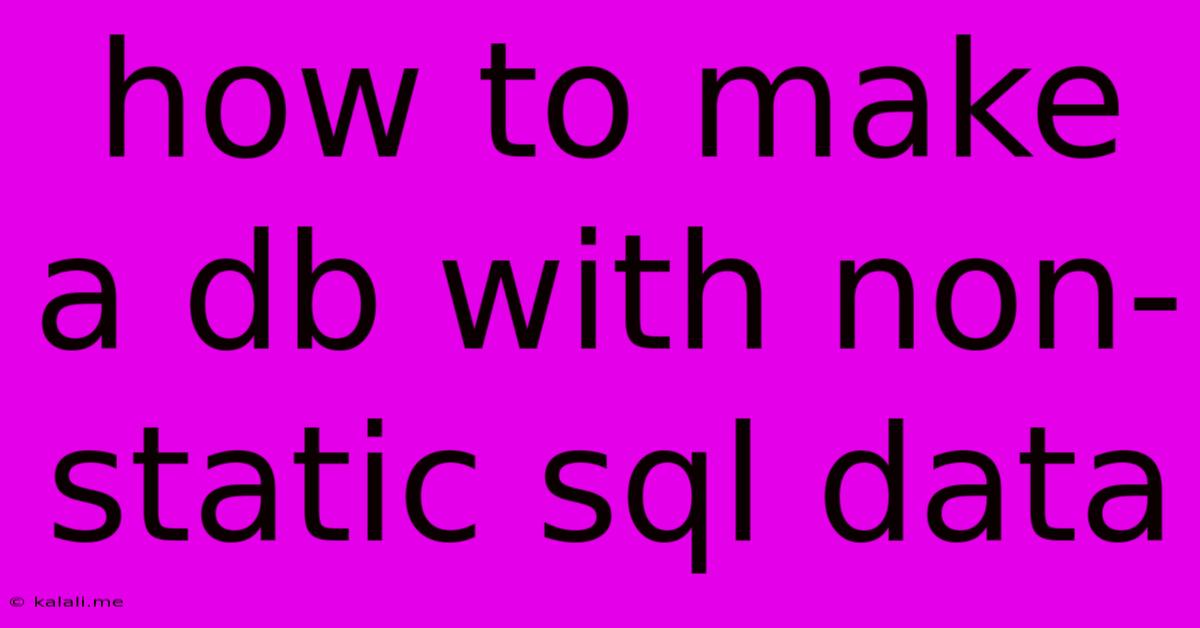How To Make A Db With Non-static Sql Data
Kalali
Jun 07, 2025 · 3 min read

Table of Contents
How to Create a Database with Non-Static SQL Data
This article explains how to populate a database with data that isn't hardcoded into your SQL scripts. We'll cover various methods for achieving this, focusing on dynamic data input that's more flexible and scalable than using static INSERT statements. This is crucial for applications requiring frequent data updates or large datasets.
Why Avoid Static SQL Data?
Hardcoding data directly into your SQL scripts (using INSERT INTO statements with fixed values) is inefficient and inflexible. Imagine needing to update even a single value; you'd have to modify your SQL script and re-execute it. This approach is unsustainable for anything beyond the smallest databases. Using non-static data allows for:
- Easier updates: Modify data without altering your SQL scripts.
- Scalability: Handle large volumes of data without manual intervention.
- Maintainability: Keep your database management clean and organized.
- Flexibility: Adapt to changing data requirements quickly.
Methods for Handling Non-Static SQL Data
Here are several effective strategies for populating your database with dynamic data:
1. Using External Files (CSV, JSON, XML)
This is a common and straightforward method. You can store your data in a file (CSV is particularly popular for its simplicity) and then use SQL commands to import it.
- CSV Import (Example using PostgreSQL):
COPY your_table (column1, column2, column3)
FROM '/path/to/your/file.csv'
DELIMITER ','
CSV HEADER;
- Other Database Systems: Most database systems provide similar
COPYorIMPORTcommands with options for handling different delimiters and file formats. Remember to adjust the command based on your specific database system (MySQL, SQLite, etc.).
2. Using Programming Languages (Python, PHP, Java, etc.)
This offers the most flexibility and control. You can use a programming language to generate SQL INSERT statements dynamically based on your data source (another database, an API, user input, etc.).
- Python Example (Illustrative):
import sqlite3
conn = sqlite3.connect('mydatabase.db')
cursor = conn.cursor()
data = [
('Alice', 30),
('Bob', 25),
('Charlie', 35)
]
for name, age in data:
cursor.execute("INSERT INTO users (name, age) VALUES (?, ?)", (name, age))
conn.commit()
conn.close()
This Python snippet demonstrates how to insert data into an SQLite database. You can adapt this approach to other database systems and data sources.
3. Using Database Stored Procedures
Stored procedures are pre-compiled SQL code that resides within the database. You can create a stored procedure to handle data insertion dynamically, perhaps based on input parameters or internal database functions. This approach is especially beneficial for complex insertion logic.
4. Data Migration Tools
For large-scale data migrations, specialized tools are often used. These tools provide features for data transformation, validation, and error handling, streamlining the process considerably.
Choosing the Right Method
The best method depends on your specific needs:
- Small datasets, simple structure: CSV import is often sufficient.
- Large datasets, complex transformations: Programming languages offer greater control.
- Frequent updates, complex logic: Stored procedures provide efficiency and encapsulation.
- Massive data migrations: Dedicated migration tools are necessary.
Remember to always back up your database before making significant changes. By employing these techniques, you can effectively manage and populate your database with dynamic data, improving your application's flexibility, scalability, and maintainability. This approach is a significant step toward building robust and adaptable database systems.
Latest Posts
Latest Posts
-
Can You Put A Teflon Pan In The Oven
Jun 07, 2025
-
Word For Beginners Whith Expensive Stuff
Jun 07, 2025
-
Screen Flashes Black Coming In And Out Of Water Minecraft
Jun 07, 2025
-
Spade Bits Drill Hole In The Desk
Jun 07, 2025
-
Contact Us When Your Footer Has Your Information
Jun 07, 2025
Related Post
Thank you for visiting our website which covers about How To Make A Db With Non-static Sql Data . We hope the information provided has been useful to you. Feel free to contact us if you have any questions or need further assistance. See you next time and don't miss to bookmark.